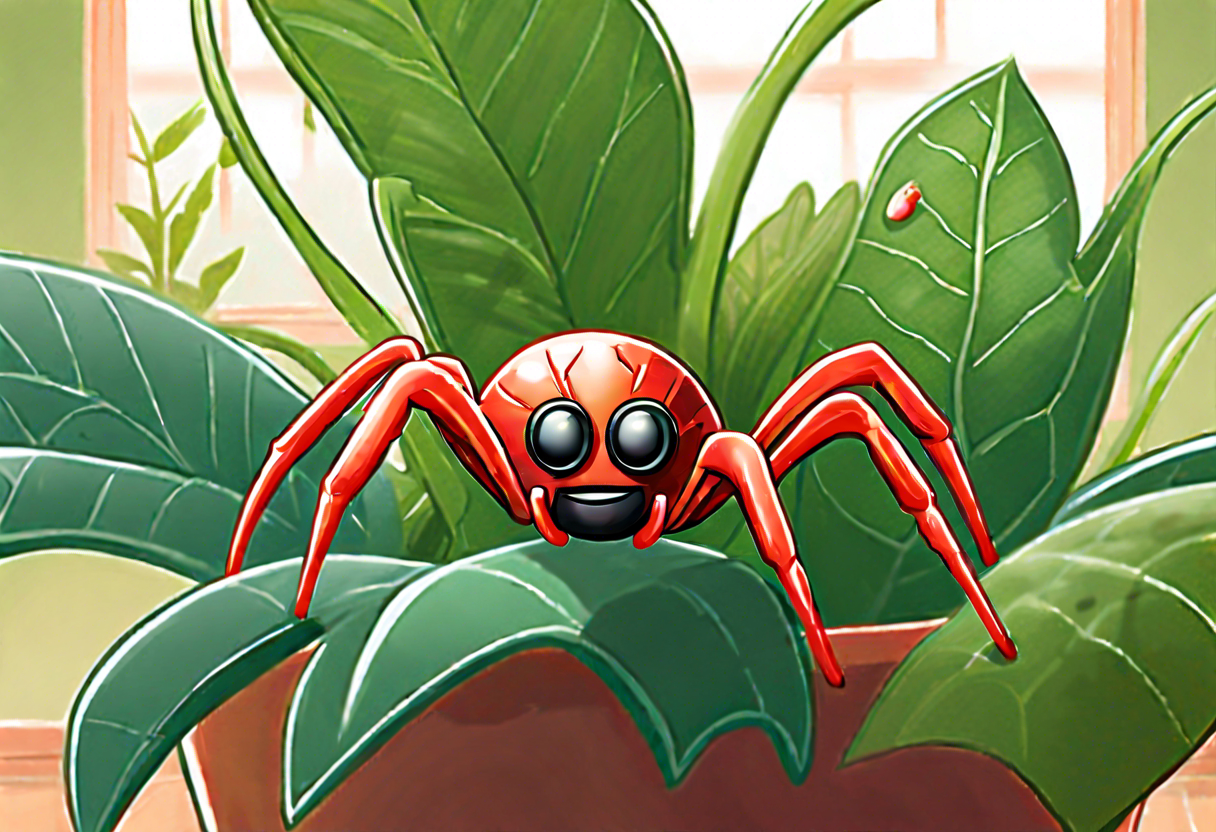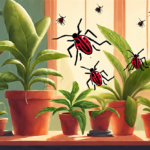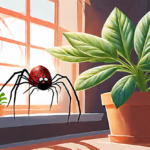Understanding Spider Mites and Their Impact on Indoor Plants
Spider mites are tiny pests that can wreak havoc on your indoor plants if left untreated. These arachnids are not insects but are closely related to spiders and ticks. They are incredibly tiny, ranging in size from 0.5mm to 1mm, making them difficult to spot with the naked eye. Despite their minuscule size, spider mites can cause significant damage to your beloved indoor plants.
Spider mites are attracted to indoor plants due to the warm and dry conditions typically found in homes. These pests feed on the sap of plants, piercing the leaves and sucking out the valuable nutrients. As a result, the leaves may turn yellow, develop brown or gray spots, become speckled, or even wither and die. The damage caused by spider mites weakens the overall health and vitality of indoor plants, making them more susceptible to other pests and diseases.
Furthermore, spider mites reproduce rapidly, with each female laying up to 100 eggs during her lifespan. These eggs hatch within a few days, leading to an exponential increase in the mite population. In favorable conditions, spider mites can complete their life cycle in as little as a week, allowing their numbers to grow rapidly. This rapid multiplication makes it crucial to address a spider mite infestation promptly to prevent further damage to your indoor plants.
It’s important to note that spider mites are not limited to a specific type of indoor plant. They can infest a wide range of plants, including but not limited to, houseplants, vegetable plants, and ornamental plants. This makes it crucial for indoor gardeners to be vigilant and proactive in preventing and managing spider mite infestations.
Now that we understand the impact spider mites can have on indoor plants, it’s essential to learn how to identify signs of infestation and take appropriate action to control and eliminate these pests effectively.
Identifying Signs of Spider Mite Infestation on Indoor Plants
Spider mites can wreak havoc on indoor plants, causing stunted growth, yellowing leaves, and even the death of the plant if left untreated. These tiny arachnids are capable of reproducing rapidly, making it crucial to identify the signs of their presence early on. By recognizing the indicators of a spider mite infestation, you can take immediate action to control and eliminate these pests.
One of the first signs that your indoor plants may be infested with spider mites is the appearance of small yellow or brown spots on the leaves. These spots are the result of the mites feeding on the plant’s sap, sucking out vital nutrients and causing damage in the process. If left unattended, the spots can multiply and cover a larger portion of the leaves, leading to their eventual wilting and death.
Another clear indication of spider mite infestation is the presence of spider webs on the undersides of leaves or in the plant’s crevices. These webs are not like the ones you typically associate with spiders, but rather fine silk-like strands that form a protective barrier around the mite colonies. If you notice these webs, it is a sure sign that spider mites have made their home on your indoor plants.
In addition to visible signs, there are also physical symptoms that indicate the presence of spider mites. One such symptom is the development of tiny yellow or white specks on the leaves. These specks are actually the mites themselves, and their small size can make them difficult to spot without close inspection. To check for spider mites, gently shake the plant over a piece of white paper or cloth. If you see moving specks that resemble dust, it is likely that you have an infestation.
Other symptoms of spider mite infestation include leaf curling, discoloration, and a general decline in the plant’s overall health. Infested plants may also exhibit a silvery appearance on the leaves, indicating damage caused by the mites’ feeding activity. If you notice any of these signs, it is crucial to take immediate action to prevent the infestation from spreading to other plants in your indoor garden.
Being able to identify the signs of spider mite infestation on your indoor plants is essential for their health and well-being. By paying close attention to the appearance of spots, the presence of spider webs, and the physical symptoms exhibited by the plants, you can take timely and appropriate measures to control and eliminate these pests. Regular monitoring and proactive pest management are key to maintaining a thriving indoor garden and preventing future infestations. So, stay vigilant and keep your plants healthy and pest-free!
Effective Natural Remedies to Eliminate Spider Mites from Indoor Plants
Spider mites, tiny pests that belong to the spider family, can be a nightmare for indoor plant enthusiasts. These microscopic creatures are known for their ability to wreak havoc on plants, causing discoloration, stunted growth, and even death if left untreated. Fortunately, there are several natural remedies that can help you combat spider mite infestations without resorting to harsh chemicals. Here are some effective methods to get rid of spider mites on your indoor plants.
1. Neem Oil Spray: Neem oil works as a potent natural insecticide and has been used for centuries to control pests. Mix two teaspoons of neem oil with one teaspoon of liquid dish soap and one liter of water. Spray this solution onto the affected plants, making sure to cover both the tops and undersides of the leaves. Repeat every seven to ten days until the infestation is under control.
2. Water Spray: Spider mites thrive in dry conditions, so using a fine mist of water can be an effective way to discourage them. Spray the leaves of your plants with water on a regular basis to increase humidity and deter the mites. This method is best used in combination with other natural remedies for maximum effectiveness.
3. Rubbing Alcohol Spray: Spider mites dislike alcohol, making it an excellent weapon against them. Mix one part rubbing alcohol with one part water and spray the solution on the affected plants. Make sure to target the undersides of the leaves where spider mites tend to hide. Repeat this process once a week until the infestation is gone.
4. Predatory Mites: Introducing predatory mites that feed on spider mites can help control the infestation. These beneficial insects can be purchased online or from garden centers. Follow the instructions provided carefully to ensure the proper release of predatory mites in your indoor environment.
5. Horticultural Oil: Horticultural oils, such as mineral oil or insecticidal soap, smother spider mites and their eggs, eliminating them effectively. Dilute the oil according to the manufacturer’s instructions and spray it directly onto the affected plants. Make sure to cover all surfaces of the leaves, as well as the stems. Repeat every seven to ten days until the pests are eradicated.
By incorporating these natural remedies into your spider mite control regimen, you can effectively eliminate infestations on your indoor plants. It’s important to note that prevention is key in avoiding future infestations. Regularly inspect your plants for any signs of spider mites or other pests. Quarantine any new plants before introducing them to your indoor garden, as they may carry pests. maintain a clean and healthy growing environment by removing dead leaves and debris regularly.
Remember, early detection and immediate action are crucial in dealing with spider mites. By following these natural remedies and preventive measures, you can keep your indoor plants healthy and free from the destructive effects of spider mites.
Using Organic Insecticides to Control Spider Mites on Indoor Plants
Spider mites can be a persistent problem for indoor plants, causing damage to leaves and stunting growth. While there are various methods to control these pests, using organic insecticides can be an effective and environmentally friendly approach. Organic insecticides are derived from natural sources and do not contain harmful chemicals that can harm the plant or its surroundings.
One of the most commonly used organic insecticides to control spider mites is neem oil. Neem oil is derived from the neem tree and has both insecticidal and repellent properties. To apply neem oil, dilute it with water according to the manufacturer’s instructions and spray it onto the affected plants, making sure to cover the undersides of the leaves where spider mites tend to hide. Neem oil works by suffocating the mites and disrupting their life cycle, ultimately reducing their population.
Another organic insecticide that can be effective is insecticidal soap. Insecticidal soaps are made from potassium salts of fatty acids and work by breaking down the protective coating of the spider mites, causing dehydration and death. To use insecticidal soap, mix it with water according to the instructions on the packaging and spray it onto the plants, focusing on the areas with spider mite infestations. It is important to thoroughly cover the plants’ surfaces, as spider mites can be found on both the upper and lower sides of the leaves.
Diatomaceous earth is another natural product that can help control spider mites. It is a fine powder made from the fossilized remains of tiny aquatic organisms called diatoms. When sprinkled onto the plants, diatomaceous earth acts as a desiccant, absorbing the waxy coating on the spider mites’ bodies and ultimately leading to their demise. Be sure to use food-grade diatomaceous earth and follow the instructions for application.
Additionally, incorporating beneficial insects into your indoor garden can provide long-term control of spider mites. Predatory mites, such as Phytoseiulus persimilis, feed on spider mites and can help keep their populations in check. Ladybugs are also natural predators of spider mites. You can purchase these beneficial insects from garden centers or online sources and release them onto your infested plants.
When using organic insecticides, it is important to follow the instructions carefully. Some products may require multiple applications, and it is essential to reapply as directed to effectively control spider mites. It is also recommended to test any insecticides on a small portion of the plant before applying to the whole plant to ensure there are no adverse effects.
Using organic insecticides can be an effective and safe method to control spider mites on indoor plants. Neem oil, insecticidal soap, diatomaceous earth, and beneficial insects are all viable options to consider. By incorporating these organic solutions into your pest control practices, you can effectively eliminate spider mites and protect the health of your indoor plants.
Preventive Measures to Avoid Spider Mite Infestations in Indoor Plants
Spider mite infestations can wreak havoc on your indoor plants, causing damage and potential loss of your beloved greenery. These tiny pests thrive in warm and dry environments, making indoor settings the perfect breeding ground for them. To prevent spider mite infestations and keep your indoor plants healthy, it is essential to adopt a few preventive measures. Here are some effective strategies to keep spider mites at bay:
1. Regularly inspect your plants: Take the time to inspect your indoor plants, paying close attention to the undersides of leaves, where spider mites often gather. Look for tiny webs, discolored spots, or stippling on the foliage, which are common signs of spider mite activity. Regular inspections will allow you to catch an infestation in its early stages and take swift action to prevent further spread.
2. Maintain proper humidity: Spider mites thrive in dry conditions, so maintaining proper humidity levels can discourage their proliferation. Use a humidifier or place your plants on a tray filled with water and pebbles, ensuring the water level remains below the pot’s bottom. This will create a humid microclimate around your plants, making it less favorable for spider mites.
3. Avoid overcrowding: Overcrowding plants can create a favorable environment for spider mites by restricting airflow and increasing moisture retention. Ensure that your plants have enough space between them to promote air circulation, reducing the risk of spider mite infestations. This also helps prevent infestations from spreading quickly if one plant becomes affected.
4. Quarantine new plants: Whether you buy new plants or receive them as gifts, it’s crucial to quarantine them for a few weeks before placing them near your existing indoor plants. This isolation period allows you to closely monitor the new plants for any signs of spider mites or other pests. If you discover an infestation, you can take appropriate measures to eliminate the problem before it spreads to your other plants.
5. Increase plant resilience: Spider mites tend to target weak and stressed plants. By providing your indoor plants with optimal growing conditions, you can enhance their resilience against pest attacks. Make sure your plants receive adequate sunlight, water, and nutrients, as well as proper pruning and maintenance. Healthy plants are less likely to succumb to spider mite infestations.
6. Introduce beneficial insects: Ladybugs, lacewings, and predatory mites are natural enemies of spider mites. Introducing these beneficial insects into your indoor garden can help control spider mite populations. You can purchase these insects from gardening stores or online suppliers and release them into your plants’ environment at the first sign of spider mites.
7. Clean and disinfect: Regularly clean your indoor plants, wiping down the foliage to remove dust and debris. Be sure to clean both the top and bottom of the leaves, where spider mites often hide. Disinfect your gardening tools and pots as well to prevent the transfer of pests from one plant to another.
By incorporating these preventive measures into your indoor plant care routine, you can significantly reduce the risk of spider mite infestations and keep your indoor plants thriving. With proper diligence and attention, you can enjoy a healthy and pest-free indoor garden all year round.
Conclusion
Spider mites can wreak havoc on indoor plants, causing significant damage if left untreated. Understanding their impact is crucial for effective pest management. By recognizing the signs of infestation, such as yellowing leaves and fine webbing, you can take early action to prevent further damage. Several natural remedies have proven effective in eliminating spider mites from indoor plants.
One natural remedy is the use of neem oil, known for its insecticidal properties. Diluting neem oil with water and applying it to the affected plants can suffocate spider mites and disrupt their life cycle. Another option is using a solution of water and mild dish soap to create a soapy spray. This solution can effectively kill spider mites by coating their bodies and suffocating them.
Additionally, using organic insecticides can help control spider mite populations on indoor plants. Products containing ingredients like pyrethrins, derived from chrysanthemum flowers, can be effective in killing spider mites without harming the plants or the environment. It is essential to follow the instructions on the product labels and apply the insecticides as directed to ensure their effectiveness.
Preventive measures are also critical in avoiding spider mite infestations in indoor plants. Regularly inspecting plants for signs of spider mites or other pests is essential to catch infestations early. Isolating new plants before introducing them to your indoor garden can prevent the spread of any potential pests. Additionally, maintaining proper humidity levels and providing adequate ventilation can create an unfavorable environment for spider mites to thrive.
Addressing spider mite infestations on indoor plants requires a multi-faceted approach. By understanding the impact of these pests, detecting signs of infestation, employing natural remedies and organic insecticides, as well as implementing preventive measures, you can effectively control and eliminate spider mites from your indoor plants. Remember to always read and follow the instructions on any product you use, and be patient as it may take time to completely eradicate spider mites. With diligence and proper care, you can enjoy healthy and thriving indoor plants free from spider mite damage.


